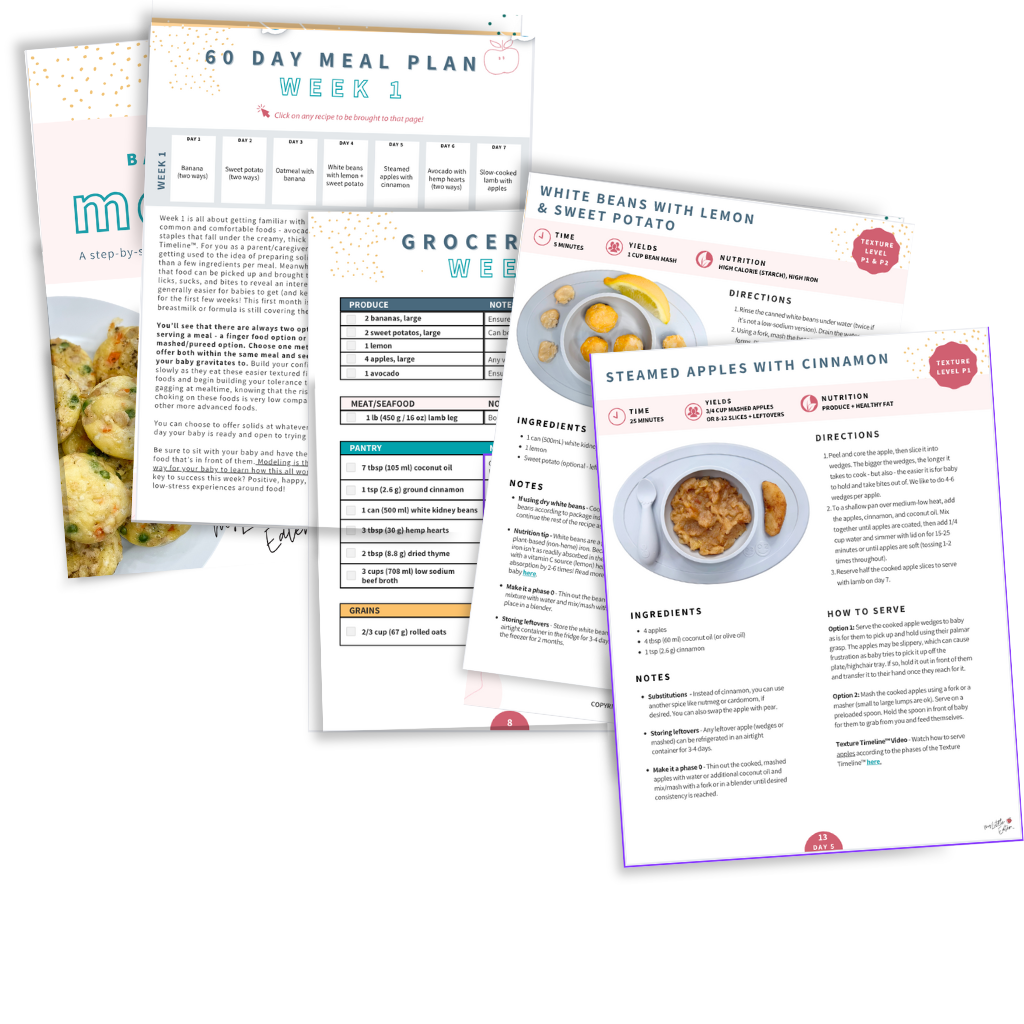This post was sponsored by Bobbie and contains affiliate links, please view our disclosure policy for more details.
As parents, we want to make sure our little ones are getting all the nutrients they need for proper growth. One of those essential nutrients is vitamin D – which is crucial for so many functions in the body and for helping your baby develop strong bones.
Your doctor probably told you that your baby would need to take vitamin D drops very soon after birth…but did they explain why it was so important? Did they let you know how long to give your baby these drops or what drops to buy?
Did they talk about what foods to offer your baby that provide vitamin D after starting solids? Did they tell you that it’s beneficial to continue offering vitamin D past 1 year of age?
We’re guessing you likely answered no to at least one of those questions, and you may even have some more unanswered questions to add to the list!
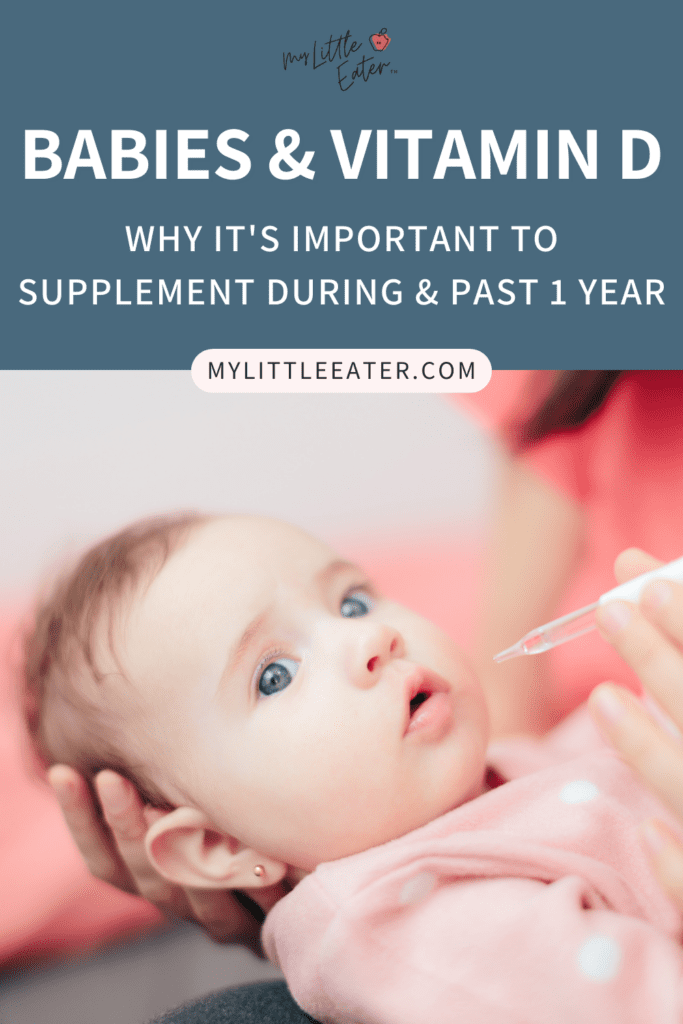
In this blog, we’re here to answer all of these and clear up any concerns you may have about vitamin D drops for your baby and toddler.
One of our favorite vitamin D supplements for babies is Bobbie organic vitamin D drops! They’re ideal for combo-fed and breastfed babies to provide the AAP-recommended amount of vitamin D that babies need daily.
Why do we love these drops in particular? They’re certified USDA organic, vegan (no animal byproducts), non-GMO (genetically-engineered ingredients), gluten-free, and made without most of the top allergens. They do not include peanuts, eggs, wheat, milk, fish, shellfish, soy, or sesame. It doesn’t get any better than that!
Use code Eater10 for 10% off your first purchase of Bobbie’s Organic Vitamin D Drops (and Bobbie’s Organic Probiotic Drops too!).
(Discount will only be applied once and cannot be combined with other offers.)
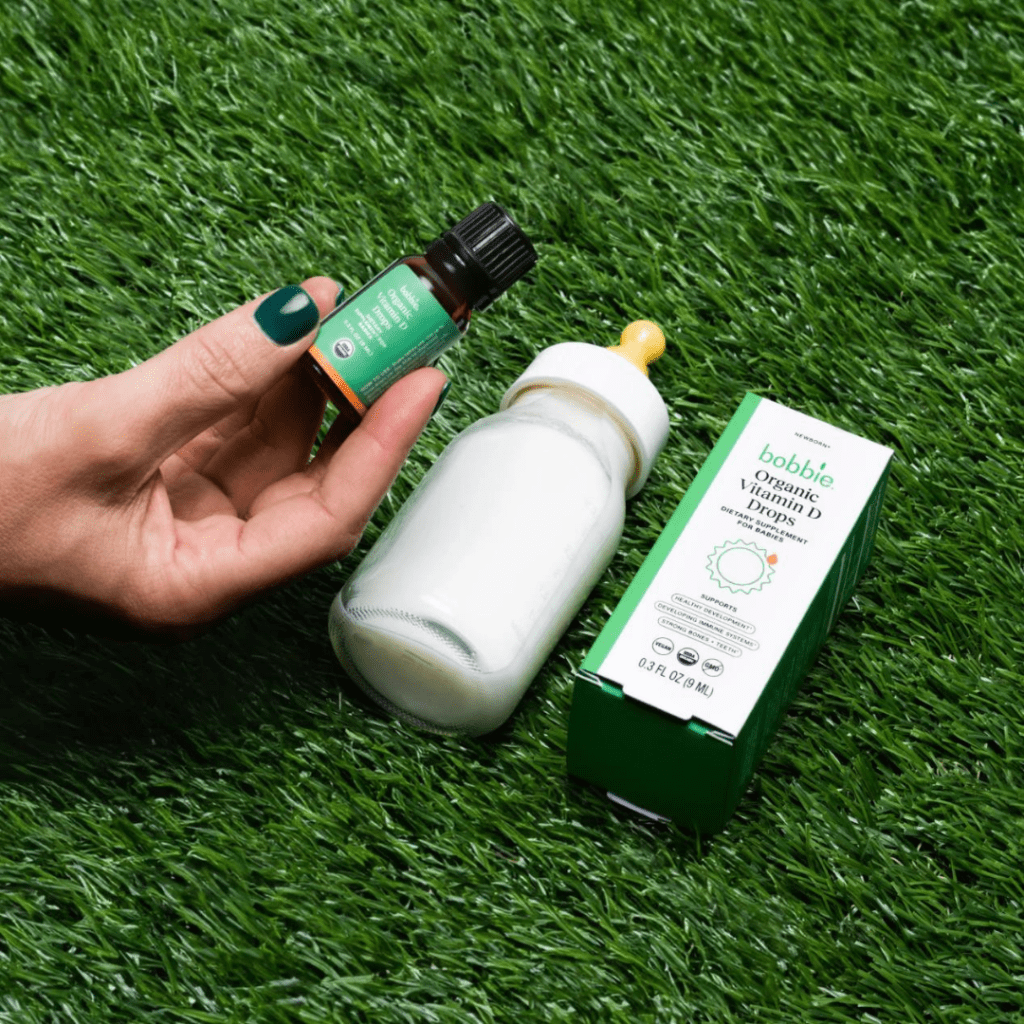
Note: The recommendations outlined in this blog post are for informational purposes only. They are not prescriptive, nor are they individualized. Always consult your doctor and/or dietitian for specific advice before taking any vitamin or mineral supplement.
Table of Contents
Why vitamin D is crucial for babies
Vitamin D, which acts as a hormone and not a vitamin, is used in almost every cell process in our body! It’s essential for your baby’s bone health and growth, supports proper immune function and development, plays a role in cancer prevention, and so much more (1, 2).
Daily supplementation of vitamin D has been recommended for exclusively or partially breastfed infants in Canada and the United States since the 1960s (3, 4). Formula-fed infants may receive a different recommendation because formula is fortified with vitamin D – we’ll get to those specifics in a bit and go over what we recommend too!
Researchers have concluded that vitamin D supplements are an effective preventative measure against rickets – this alone justified offering your baby a vitamin D supplement from birth (3, 5).

Vitamin D is a critical tool that’s needed to help the body absorb calcium into the bloodstream (6). Without enough vitamin D, our bodies are unable to absorb calcium which can lead to rickets. Rickets is a condition in which healthy bones become soft and very weak, leading to a whole host of other issues.
Rickets tends to occur in children between 3-18 months of age (7). It’s uncommon in most developed countries due to the current recommendations and availability of vitamin D drops for babies to prevent rickets, along with more widely available access to dairy products fortified with vitamin D (8).
How much vitamin D do babies and toddlers need?
The recommendation is that all infants from 0-12 months have at least 400 IU (international units) of vitamin D daily beginning soon after birth (4, 5, 7, 9, 11). For children 1-18 years, the recommendation is 600 IU of vitamin D daily (8).
The table below shows the recommended daily amount of vitamin D required for babies 0-12+ months and the tolerable upper intake level for vitamin D daily (5, 8, 9, 10).
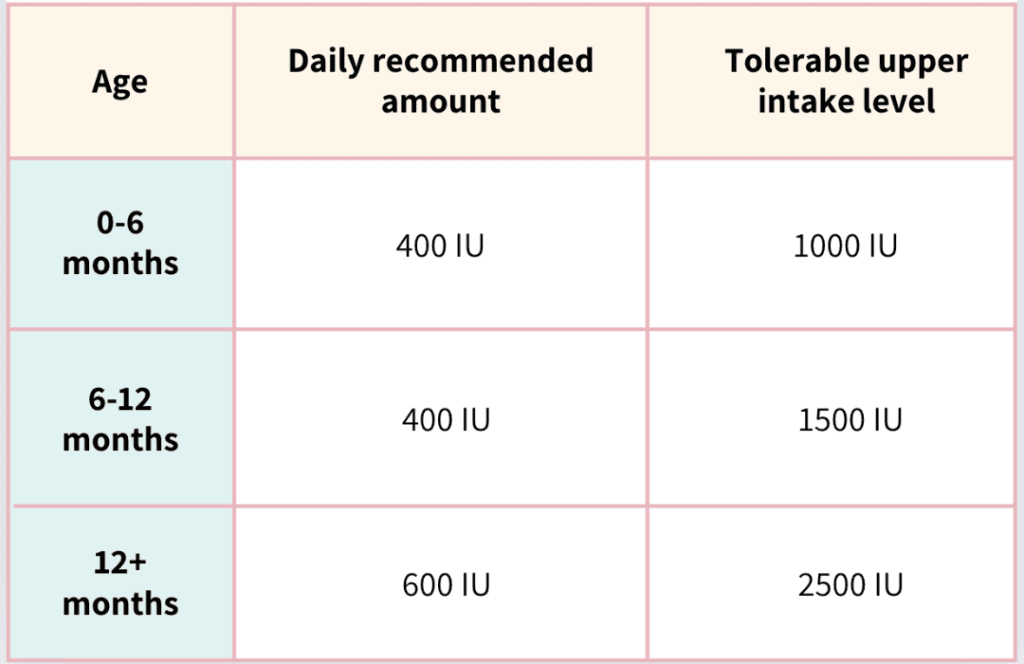
The tolerable upper intake level (UL for short) is the highest level of a nutrient that you can take every day without the likelihood of any negative impacts on your health, for most infants or people in general (10).
For example, if you’re supplementing your 7 month old with 400 IU of vitamin D, plus they get some from food or the sun, as long as they aren’t going over 1500 IU daily, it’s ok that they’re getting more vitamin D than the recommended daily amount.
Depending on your method of feeding (formula, breast milk, or both), your baby may or may not need a vitamin D supplement to reach the daily recommended amount of 400 IU per day. Let’s dive into the details!
Do breastfed babies need a vitamin D supplement?
Breast milk typically does not provide all the vitamin D a baby needs. Therefore, the recommendation is that all breastfed babies will need a supplement of 400 IU of vitamin D per day beginning shortly after birth (12).
Infants who are combo-fed, meaning they receive a mixture of breast milk and formula, should also get a supplement of 400 IU per day to ensure they receive an adequate vitamin D intake (7). Again, it’s ok if your baby gets some vitamin D from formula and 400 IU from a supplement daily since the upper limit is so high.

Can breastfeeding mothers supplement themselves and not their babies?
You may have seen online that some mothers of breastfed babies take very high doses of vitamin D to raise the levels in their breast milk as opposed to offering babies a vitamin D supplement. Researchers have concluded that breast milk vitamin D levels can be raised this way (13).
However, the amount of supplementation required to meet infant vitamin D needs is 6400 IU/day, which is above the tolerable upper intake level of 4000 IU per day for adult women (13). While no negative effects were seen in the studies, in general, taking more than the tolerable upper intake level of any nutrient is not recommended.
Do formula-fed babies need a vitamin D supplement?
The FDA requires all US formulas to be fortified with vitamin D, so in theory, a formula-fed baby does not need to take vitamin D drops if they’re consuming enough formula (8).
All formulas sold in the United States must be fortified with 40-100 IU/100 kcal of vitamin D, and 40-80 IU/100 kcal is the required amount in Canada (14). So whether or not your baby is getting enough vitamin D through formula depends on the type of formula they drink and how much vitamin D has been added to it.

Therefore, making a blanket statement that formula-fed babies don’t need vitamin D supplementation can leave many babies deficient because they just aren’t drinking enough to meet their daily requirements. And if that’s the case, they NEED to be supplemented with vitamin D drops.
It’s not realistic for parents to monitor vitamin D intake so closely, so we take a more conservative approach.
My Little Eater
Recommendation
Recommendation
We recommend giving baby a vitamin D supplement regardless of their formula intake so you’re not concerned about it or mistakenly thinking they’re getting enough vitamin D when they’re really not.
Your baby could be getting 800 IU a day if they’re drinking the correct amount of formula in combination with a supplement, but that’s still under the daily upper limit, so they’ll be completely safe.
Do babies need vitamin D drops after starting solids?
Yes!
All babies should receive vitamin D drops starting shortly after birth and all the way up until toddlerhood and beyond. As we mentioned above, this includes all breastfed, combo-fed (partially breastfed infants who also receive formula), and formula-fed babies (9).
When babies start solids at around 6 months old, you can incorporate foods with vitamin D. However, it’s extremely difficult to get enough vitamin D through food and therefore we still recommend providing 400 IU through supplementation daily.
How long do you need to give your baby or toddler vitamin D drops?
The universal recommendation for vitamin D supplementation is to offer it until at least 12 months of age (9). Beyond 12 months of age, supplementation is typically only recommended for children at a higher risk of developing vitamin D deficiency (9).

A child would be considered at high risk for developing vitamin D deficiency if they have limited sun exposure, poor nutrition and/or low intake of foods containing vitamin D, or a chronic condition (like celiac disease or Crohn’s disease).
However, there is a lack of evidence supporting the cut-off of 12 months.
Children over 1 year of age who do not get 400 IU of vitamin D per day naturally through foods or vitamin D–fortified foods (like milk) should receive a vitamin D supplement of at least 400 IU/day (7).
As was shown in the table earlier on, vitamin D requirements increase from 400 IU per day to 600 IU at 12 months of age (12). At this age, it’s assumed that children are eating at least some foods containing vitamin D and are getting some sun exposure compared to what they would have been getting in the first year of life.
Still, it’s extremely difficult for children to get 600 IU of vitamin D naturally without added supplementation, regardless of where they live or if there are other high-risk factors present.
We’ll go over how your toddler may naturally get vitamin D later on so you can assess if a supplement is needed for your child.

My Little Eater
Recommendation
Recommendation
We recommend all children continue taking a vitamin D supplement well beyond babyhood and into adulthood.
This is true whether or not you or your child is seen as high risk for vitamin D deficiency. However, it’s especially important if you or your child (14):
- Live in the northern hemisphere
- Wear sunblock while outside
- Have the body and head covered when outside
- Have darker skin (the darker your skin, the less vitamin D you make from sunlight exposure)
- Have a condition that limits fat absorption like Crohn’s disease, celiac disease, or ulcerative colitis
Ideally, they’re getting at least a 400 IU supplement daily to maintain a decent level of vitamin D. If you are concerned that your toddler isn’t getting much or any vitamin D from food or the sun, you can offer a 600 IU supplement daily.
Again, the upper limit is so high at this age (2500 IU/day) that getting some vitamin D naturally through foods, the sun, and a top-up from a supplement will still be very safe and far from the upper limit (9).
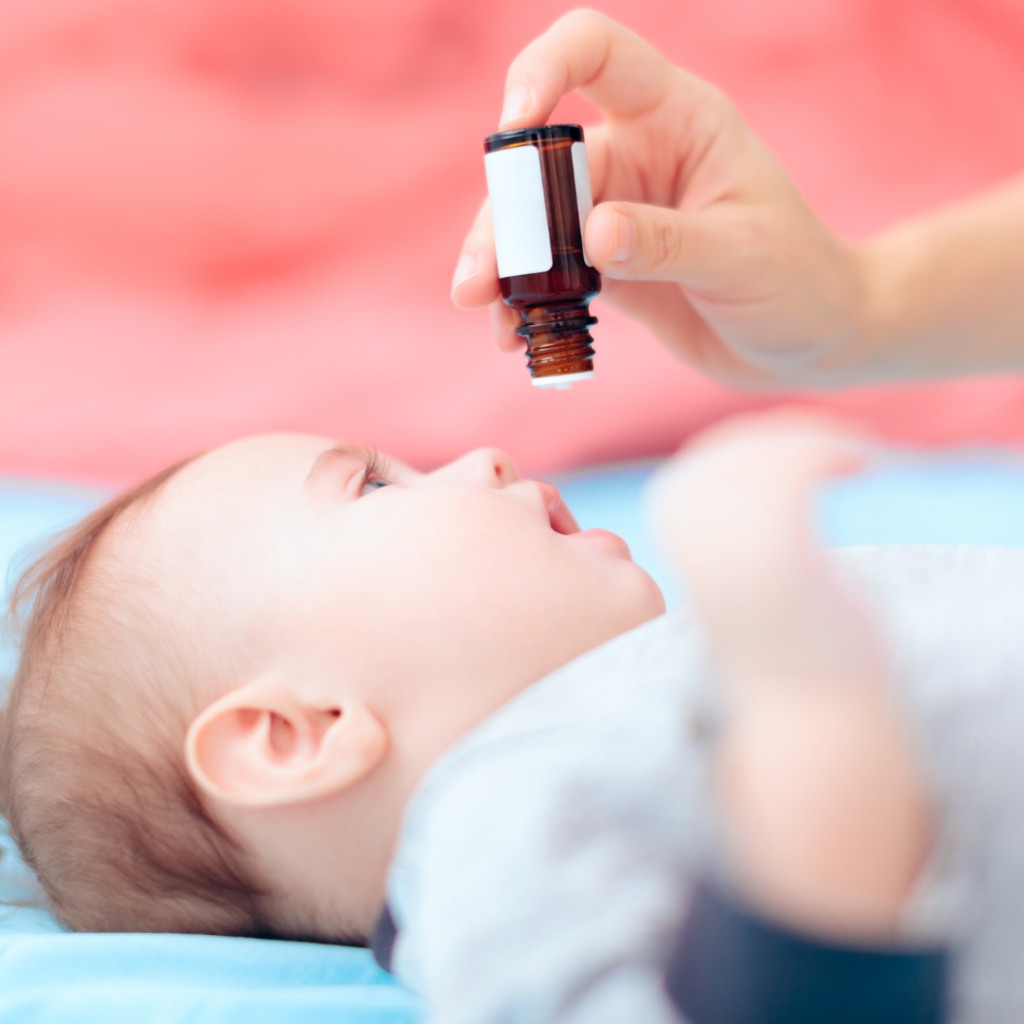
What are the best vitamin D drops for baby?
Now that you know why vitamin D is so important and how much your baby needs, let’s discuss what drops we recommend for your little one!
Two different forms of vitamin D can be used as dietary supplements. Vitamin D2 (ergocalciferol, which comes from plants) and vitamin D3 (cholecalciferol, which comes from animals) (7).
It’s recommended that you offer your baby a vitamin D3 supplement as it’s more effective for raising vitamin D levels compared to vitamin D2 (7).
As you may already know, there are a lot of brands out there that sell vitamin D drops for babies! But, not all vitamin D drops are created equally. Certain brands of vitamin D drops contain unnecessary ingredients that are not ideal for your baby.
Let’s take a look at some vitamin D drops and compare their key features!
Bobbie Organic Vitamin D Drops
Our top recommendation for vitamin D3 drops for babies is Bobbie organic vitamin D drops. They’re ideal for combo-fed or formula-fed babies (who are not consuming the minimum amount of formula needed based on the amount of vitamin D in their formula), breastfed babies, and toddlers to provide the recommended daily serving of 400 IU per day or in the case of children above 1 year of age to help reach the 600 IU daily recommended serving.
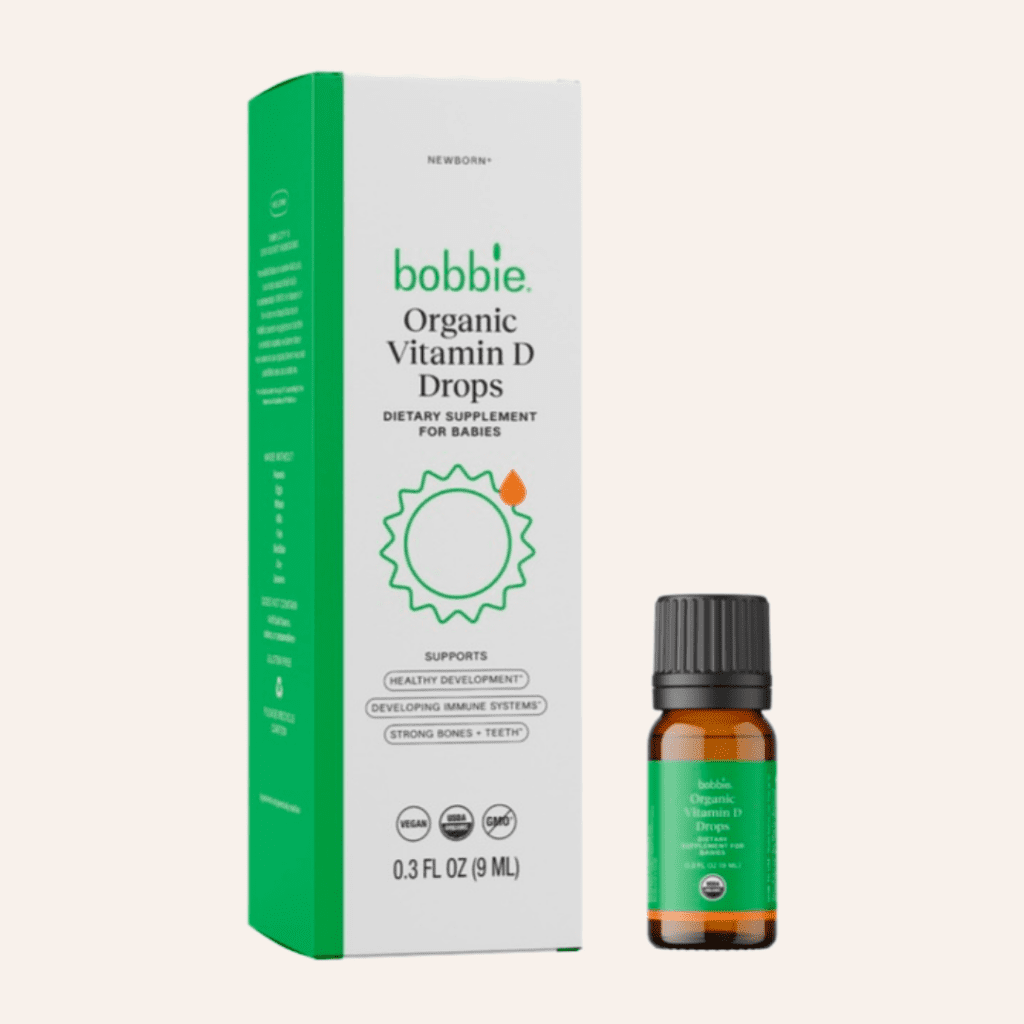
Bobbie organic vitamin D drops contain only vitamin D3, organic sunflower oil, and organic coconut medium chain triglyceride oil.
Organic sunflower oil and organic coconut medium chain triglyceride oil are both forms of healthy fats for babies. A base of fat or oil is an ideal carrier to supply vitamin D to your baby’s body.
Besides the simple organic ingredients (they’re actually certified USDA organic), why do we love Bobbie? They’re vegan (no animal byproducts), non-GMO, gluten-free, and they’re made without 8 of the top allergens! Look no further, and get your vitamin D drops from Bobbie below.
You can also use code Eater10 for 10% off your first purchase of Bobbie’s Organic Vitamin D Drops (and Bobbie’s Organic Probiotic Drops too!).
(Discount will only be applied once and cannot be combined with other offers.)
Baby D drops
Baby D drops are another excellent option! It’s made with only two naturally sourced ingredients, pure vitamin D3 and organic fractionated coconut oil.
Fractionated coconut oil is simply coconut oil that has been processed to separate the different types of fat in regular coconut oil. Fractionated coconut oil remains liquid at all temperatures and doesn’t harden at lower temperatures.
These vitamin D drops do not contain any preservatives, vitamin E, artificial flavors, colors or artificial additives. Just one drop provides the daily recommended vitamin D intake for your little one.
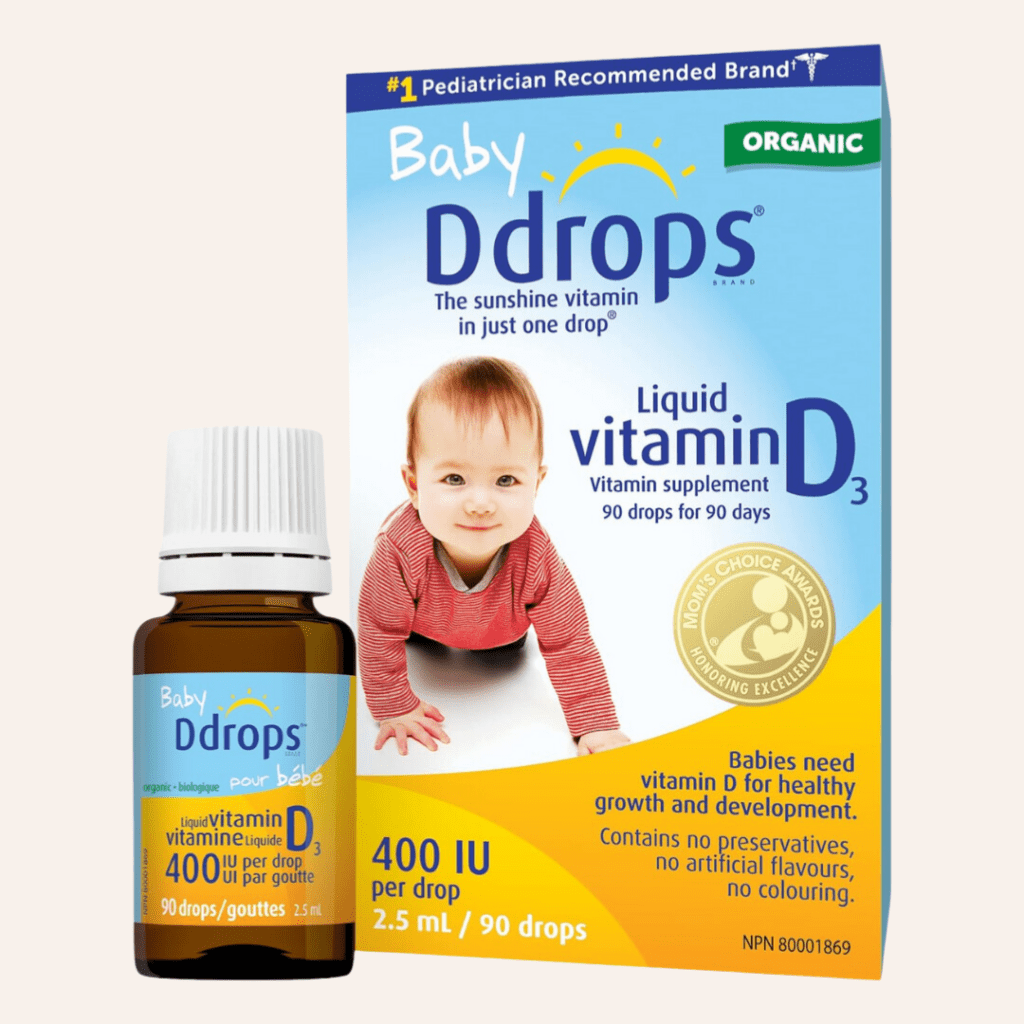
We discuss this in more detail below, but when vitamin D drops contain a high dosage of vitamin D in each drop, it can become easier for your baby to receive higher than the tolerable upper intake level. This is because if just one or two extra drops fall out of the dropper while administering it to your baby, you’re instantly doubling or tripling their dose.
This doesn’t mean you have to avoid this option completely, but it is something to keep in mind and be cautious of so you aren’t regularly offering them a much larger dose than they need.
Wellements Organic Vitamin D Drops
Wellements organic vitamin D drops contain vitamin D3, organic extra virgin olive oil, and palm medium chain triglyceride oil.
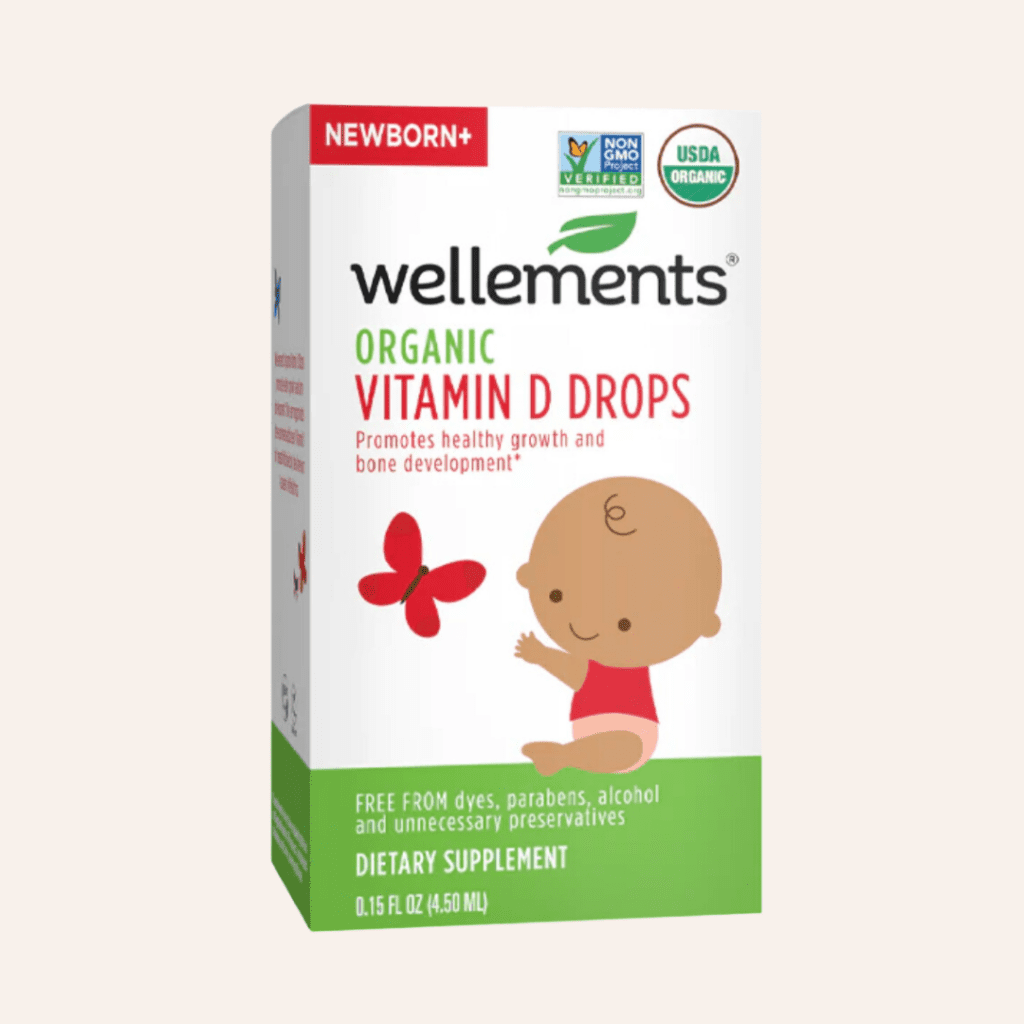
These vitamin D drops are free from gluten, parabens, artificial colors, artificial flavors, and 9 top allergens!
All you need is one drop daily to provide the recommended vitamin D intake for your little one.
These vitamin D drops meet most of the criteria we’re looking for.
However, we suggest choosing vitamin D drops that don’t use palm oil as it can impact the absorption of calcium, which is an essential nutrient for your growing baby (15).
Enfamil Vitamin D Drops
Enfamil is one of the most common brands when it comes to baby formula and baby supplements!
The ingredients found in Enfamil vitamin D drops include vitamin D3, glycerin, polysorbate 80, caramel, citric acid anhydrous, sodium citrate dihydrate, sodium hydroxide, artificial flavor, and purified water.
These Enfamil vitamin D drops do contain some additives and preservatives but are still safe for your baby and are more affordable compared to some other options on the market.
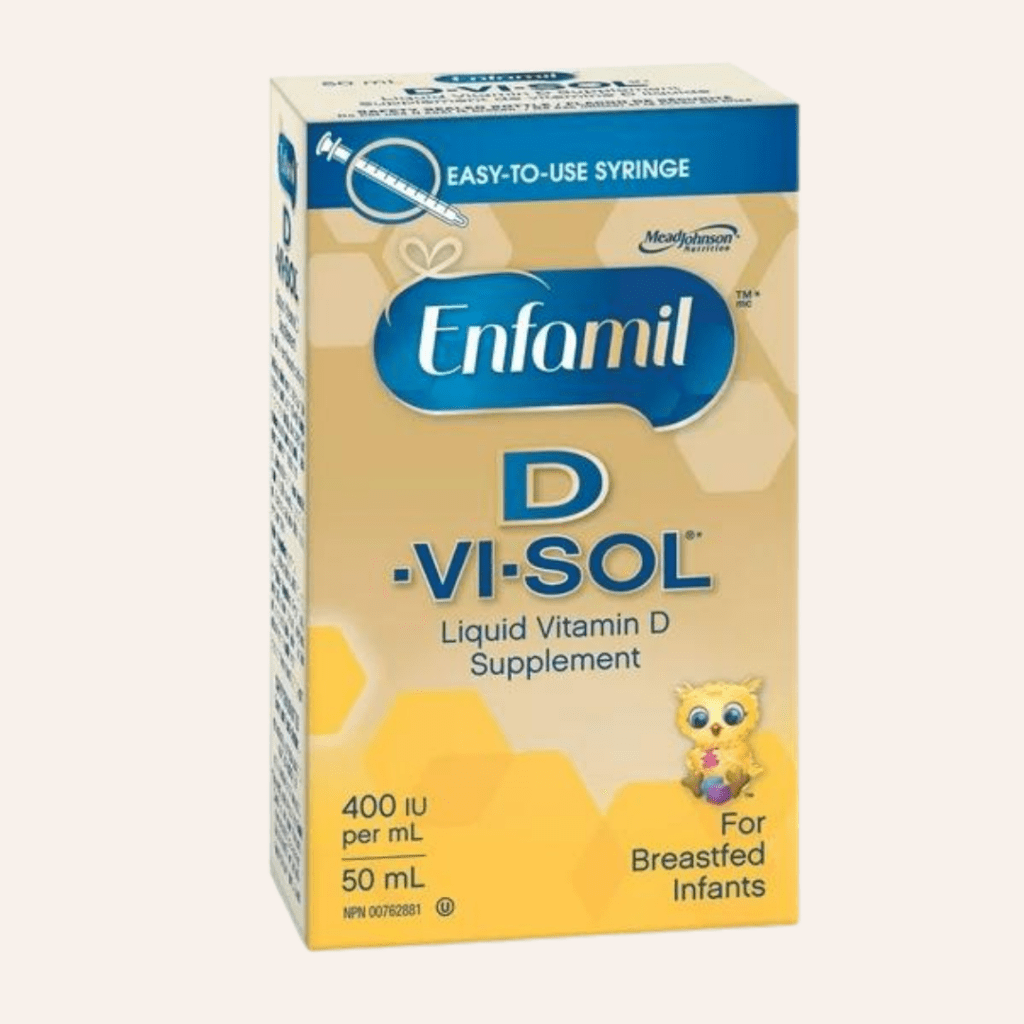
We suggest choosing vitamin D drops with simpler and cleaner ingredients if you can since your baby will be consuming them every day. This is why we recommend Bobbie, as it only contains 3 simple, clean ingredients that you can feel good about giving to your baby every day.
Let’s recap what we look for in a vitamin D drop so you can evaluate the options that are available where you live.
You want your baby’s vitamin D drops to have these key features:
- Contains vitamin D as cholecalciferol (which is vitamin D3)
- Contains a base of fat or oil (like coconut or sunflower oil)
- Free from top allergens (to avoid exposing your baby to allergens without following proper protocols)
- Sugar-free
- No artificial colors, flavors, or preservatives
- Ideally require more than 1 drop to administer proper dosage (this helps minimize the chances of accidentally providing too high of a dose if extra drops are administered)
Always read the ingredient lists carefully before choosing a supplement for your baby, and be sure to speak with your doctor before starting any new supplements.
How do I give my baby vitamin D drops?
There are a few different ways you can go about this!
You can use the provided dropper to place the drop directly into your baby’s mouth. Some options are even more simple and the bottle itself has a lid that acts as the dropper. We recommend tipping the bottle at a 45-degree angle so one drop comes out slowly and you can easily count how many you’re offering.
Aim for the inside of your baby’s cheek, not the back of their throat. We also recommend choosing a time when your baby is more calm and relaxed, if possible.
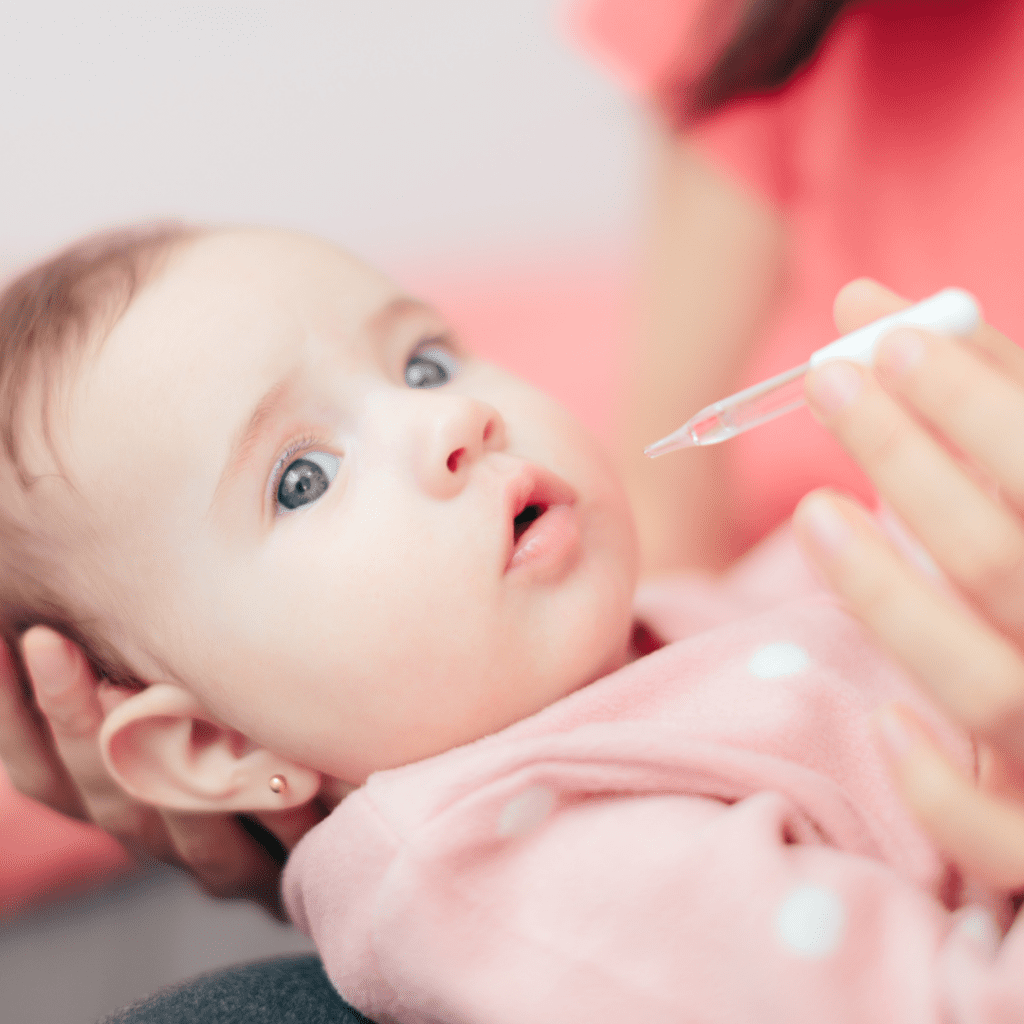
Safety Tip
Safety Tip
Do your best to avoid touching the dropper directly on or in your baby’s mouth to prevent transferring any bacteria from the mouth to the inside of the vitamin D drops bottle.
Do your best to avoid touching the dropper directly on or in your baby’s mouth to prevent transferring any bacteria from the mouth to the inside of the vitamin D drops bottle.
You can also:
- Put the drop directly on your nipple before breastfeeding. This works best if the dose is more highly concentrated and only requires a drop or two.
- Place a drop or two on the nipple of a bottle.
- Mix vitamin D drops with expressed breast milk or formula in a bottle. Many parents keep vitamin D drops close to their formula and bottles so they don’t forget to give their baby daily drops.
Note: If your baby doesn’t drink the entire bottle of breast milk or formula then they may not get their full dose of the vitamin D supplement. If this is a regular occurrence for your baby, you can put a small amount of milk in a bottle with the vitamin D drops. You can then top the bottle up after they drink that amount so you know they have their full daily dose of vitamin D.
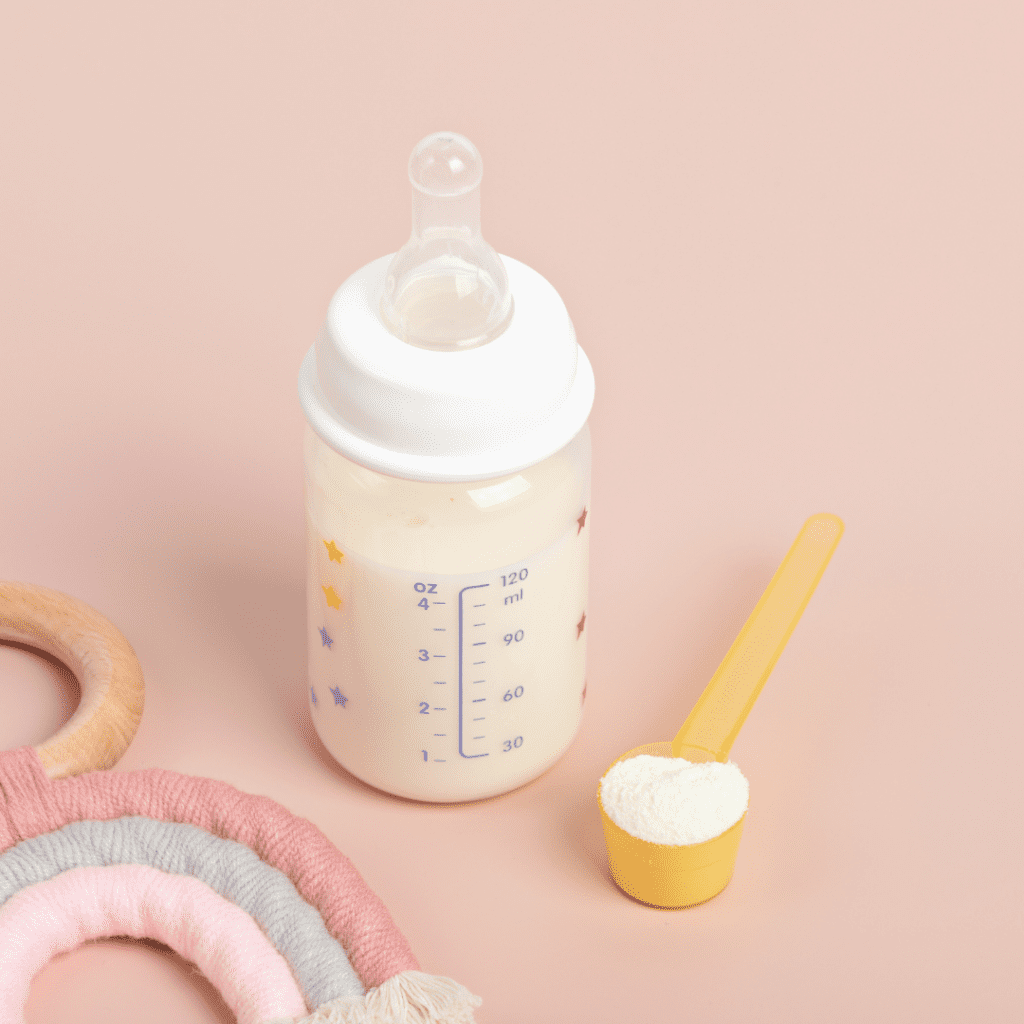
Always use the application method or dropper that comes with the vitamin drops for accurate measurements. Follow the instructions on the packaging to ensure that you’re providing the appropriate dose for your baby.
Natural sources of vitamin D
Vitamin D drops aren’t the only way for your baby to get vitamin D. However, getting the recommended daily amount naturally is extremely difficult, particularly for infants and young children.
There are two natural sources of vitamin D – food and the sun. Let’s discuss both!
What foods contain vitamin D?
Your baby can get vitamin D naturally from foods, but only once they’ve started solids at around 6 months of age.
Unfortunately, unless your little one is eating optimal quantities of foods that are high in vitamin D, they likely won’t be getting the recommended amount of 400 IU daily. This is why we discussed above that our recommendation is to continue vitamin D drops after starting solids.
There are not many foods that naturally contain vitamin D. Even fewer of those foods offer a significant amount of vitamin D. The table below shows food sources and how much vitamin D they offer per serving (16).
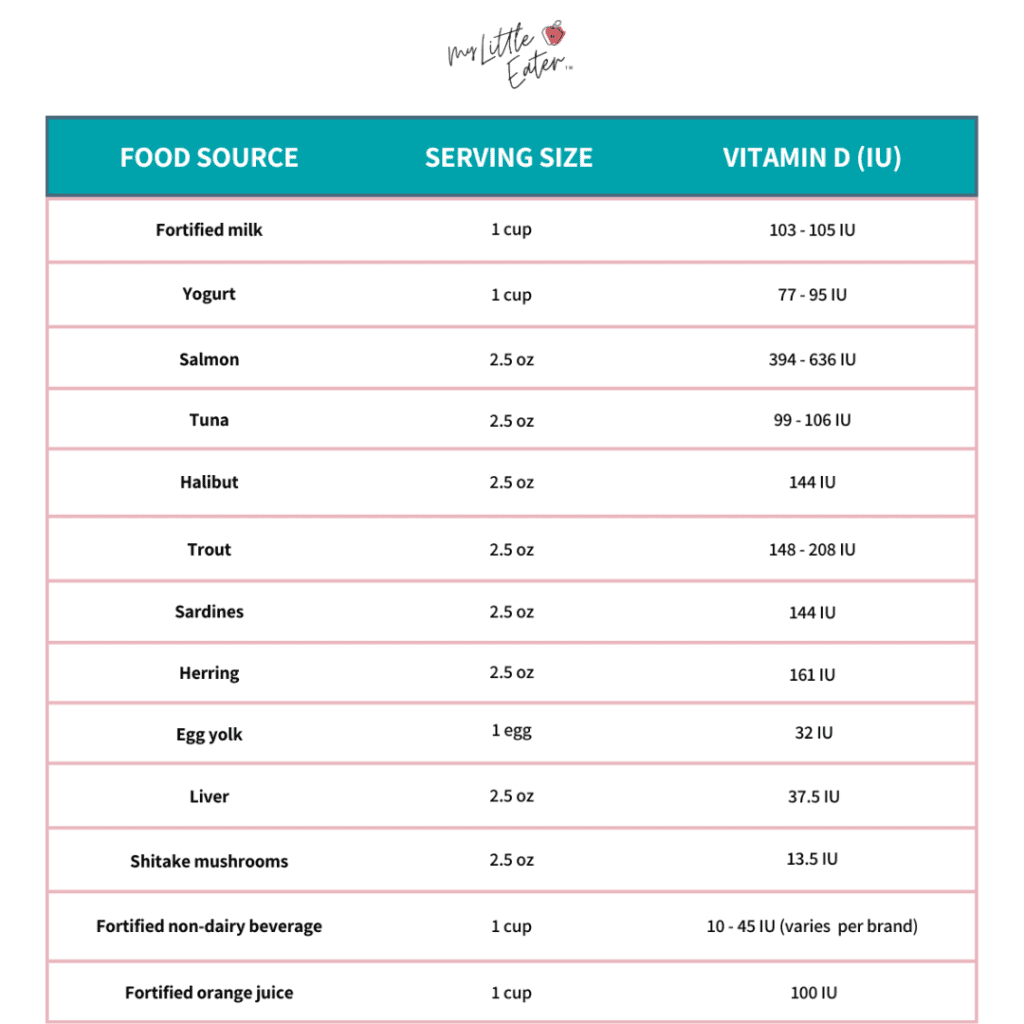
The only significant sources of vitamin D are found in fatty fish (like salmon), certain fish oils, and fortified food products like milk, yogurt, milk alternatives, and orange juice (7).
It’s very unlikely that your baby or toddler will be able to meet their daily vitamin D requirements through food alone.
This is why we continue to recommend that babies receive a supplement of 400 IU/day of vitamin D after starting solids, and even into toddlerhood despite their intake of solid foods likely increasing.
Can my baby get vitamin D from the sun?
You may have heard the nickname “the sunshine vitamin” when people talk about vitamin D. That’s because our bodies can produce vitamin D when our skin is exposed to sunlight.
While yes, you can get vitamin D from the sun, it’s advised to limit your baby’s exposure to ultraviolet solar radiation by using hats, swaddling in blankets or wearing protective clothing, and completely avoiding exposure to direct sunlight (17).

This is because the American Academy of Dermatology declared UV radiation from the sun to be a known carcinogen, so it’s not safe for your baby (or you) to get sun exposure without the use of sunscreen for protection (8).
Once your baby turns 6 months old and can wear sunscreen, they still won’t be able to get enough vitamin D from the sun. Sunscreen blocks UVB radiation, and vitamin D production in our skin requires these UVB rays (18).
All that to say – sunlight isn’t the best way for your baby to meet their vitamin D needs.
Is it possible to have too much vitamin D?
Yes.
We know we said the upper tolerable limit is very high, but it is possible to get too much vitamin D, which could be harmful (14).
Very high levels of vitamin D in the blood can lead to vomiting, muscle weakness, pain, loss of appetite, dehydration, kidney stones, and irregular heartbeat (14).
However, it’s extremely unlikely for this to happen unless very large, excessive doses of vitamin D supplements are being taken daily (14).
You cannot get too much vitamin D from sunshine because your skin limits the amount of vitamin D it makes (14). You also don’t have to worry about going over the upper limit when it comes to food. As mentioned above, it’s fairly difficult to get any significant amount of vitamin D from food other than dairy or fatty fish.
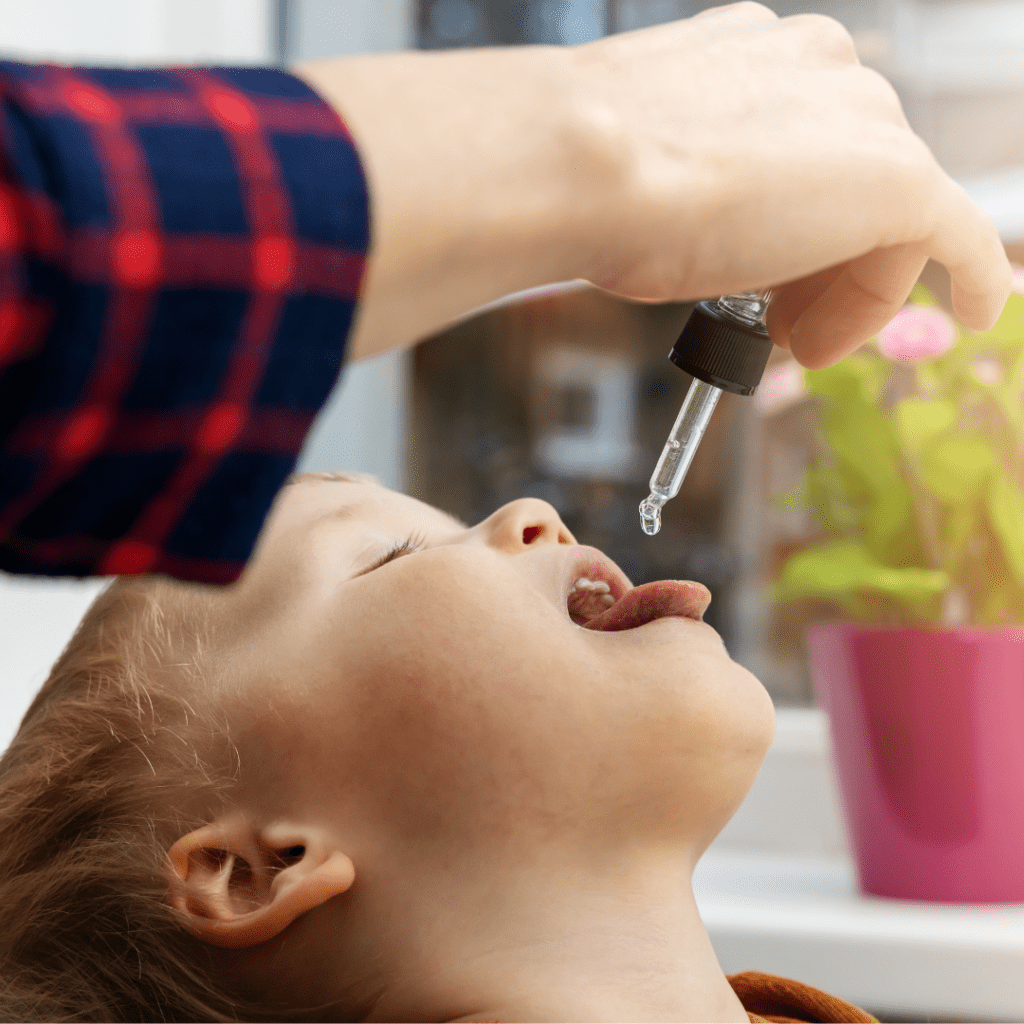
BUT – it is fairly easy to give a couple of extra drops on the tongue, so just make sure you’re sticking to the appropriate dose indicated on the label.
An extra drop or two may not seem like a big deal, but for highly concentrated forms of vitamin D that provide 400 IU per drop, you can easily be doubling or tripling their intake daily.
Vitamin D deficiency
Vitamin D deficiency is a very serious condition that can happen when your baby does not get enough vitamin D. Severe vitamin D deficiency can lead to rickets (9).
Risk factors for vitamin D deficiency
The risk factors of vitamin D deficiency include the following (7, 9, 11, 14).
In newborns and small infants...
- Maternal vitamin D deficiency: mothers with limited sun exposure, with dark skin color, and/or with low vitamin D intake throughout pregnancy.
- Prolonged exclusive breastfeeding without vitamin D supplementation.
- Preterm babies and babies who are small for their gestational age.
In older babies and children...
- Limited sun exposure: little time outdoors, dark skin color, cultural practices (such as veils), degree of latitude, the amount of cloud cover, season, the extent of air pollution, and the extent of UV protection (ie. clothes or sunscreen).
- Decrease in vitamin D intake: prolonged exclusive breastfeeding without supplementation, poor nutrition, and/or low intake of foods containing vitamin D.
- Certain medical conditions and chronic diseases (like celiac disease, Crohn’s disease, and cystic fibrosis).

Symptoms of vitamin D deficiency
Most of the time, individuals with vitamin D deficiency don’t notice any symptoms at all. It can be even more difficult to identify vitamin D deficiency in babies and young children who can’t communicate how they’re feeling. You may notice vague symptoms in your little one, but those could be signs of any number of conditions.
Possible symptoms of vitamin D deficiency include (19):
- Muscle pain
- Muscle twitches or tremors
- Bone pain
- Increased sensitivity to pain
- A tingly sensation in the hands or feet
- Waddling while walking, due to muscle weakness in the hips or legs
- A history of broken bones
- Bowed legs (when vitamin D deficiency is severe)
If you notice these symptoms, be sure to mention them to your child’s doctor and discuss whether they’ve been receiving vitamin D supplementation and if you have concerns about them being deficient.
Vitamin D FAQs
When is the best time to start giving baby vitamin D drops?
The recommendation is to start giving baby vitamin D drops very soon after birth. Once you get settled at home with your new baby, you can introduce vitamin D drops, assuming your doctor has given you the go-ahead.
You can speak to your doctor before birth about which drops they recommend, and bring them to the hospital with you. That way if you have any concerns or would like someone to show you how to use them, you can speak with the nurses or doctor helping you after your baby is born.
Should I talk to my doctor before giving my baby vitamin D drops?
Yes, before introducing any type of supplement to your baby, it’s a good idea to talk to their doctor first.
Are there any side effects associated with vitamin D drops for babies?
If you’re offering your baby the correct amount of vitamin D drops daily according to the package recommendations, and you’re not surpassing the upper limit, there are no adverse side effects to vitamin D supplementation.
What happens if I forget to give my baby vitamin D drops?
This will probably happen, and it’s ok – don’t panic! It’s not the end of the world if you forget to give your baby vitamin D drops here and there – we promise they will not develop vitamin D deficiency from missing a drop or two.
Do your best to offer them daily and keep them somewhere in your home that makes it easy to remember to offer them to your baby.
Do I have to monitor my baby’s vitamin D levels?
The only way to check vitamin D levels is through bloodwork. Therefore, you won’t be able to monitor your baby’s vitamin D levels regularly on your own. If you’re at all concerned about your baby’s vitamin D levels, you can ask your baby’s doctor for bloodwork to be done.
Do I have to offer my baby vitamin K2 with their vitamin D supplement?
As mentioned earlier on in the blog, vitamin D helps us absorb calcium into our bloodstream. Ok – we’re going to get technical here – so stay with us!
After this calcium absorption occurs with the help of vitamin D, that calcium then needs to get transported to our bones.
Enter vitamin K2.
To get the calcium from our bloodstream absorbed into our bones, we need the help of vitamin K2 (19). Vitamin K2 acts like a postal service (think FedEx) to carry the calcium from our bloodstream and deliver it to our bones.
The reason we bring this up is because long-term supplementation of vitamin D could cause a build-up of calcium in the bloodstream if there isn’t enough vitamin K2 to transport it to our bones (20). But the good news is, most people aren’t deficient in vitamin K2 (19).
If you’re eating a well-balanced diet that contains animal products, you’ll be able to get vitamin K2 from dairy products, liver, beef, pork, egg yolks, chicken, and fatty fish like salmon.
If you’re concerned that your baby is getting too much vitamin D and not enough vitamin K2, talk to your doctor. You can ask for a blood panel to be done to check your baby’s vitamin D and vitamin K2 levels.
In addition to offering a vitamin D supplement to your baby and toddler, we would also recommend in certain cases, like if your baby is vegan or vegetarian, to offer a vitamin K2 supplement.
Always talk to your doctor before introducing a supplement to your baby.
To ensure your baby is getting enough vitamin D, and isn’t consuming any unnecessary additives at the same time – look no further than Bobbie organic vitamin D drops! They’re ideal for combo-fed and breastfed babies to support healthy development, strong bones and teeth, and to support your baby’s immune system!*
*This statement has not been evaluated by the Food and Drug Administration. This product is not intended to diagnose, treat, cure or prevent any disease.
Use code Eater10 for 10% off your first purchase of Bobbie’s Organic Vitamin D Drops (and Bobbie’s Organic Probiotic Drops too!).
(Discount will only be applied once and cannot be combined with other offers.)
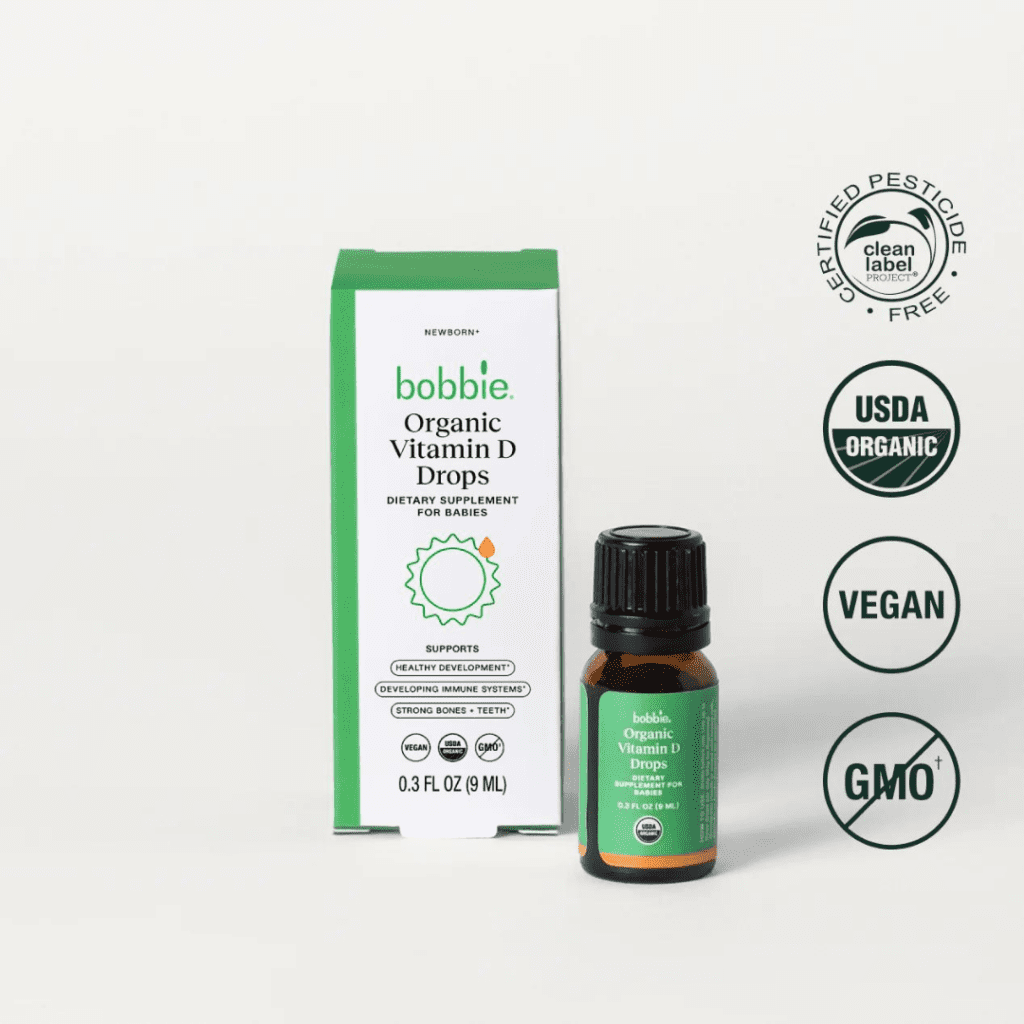
Pin this info to save for later!
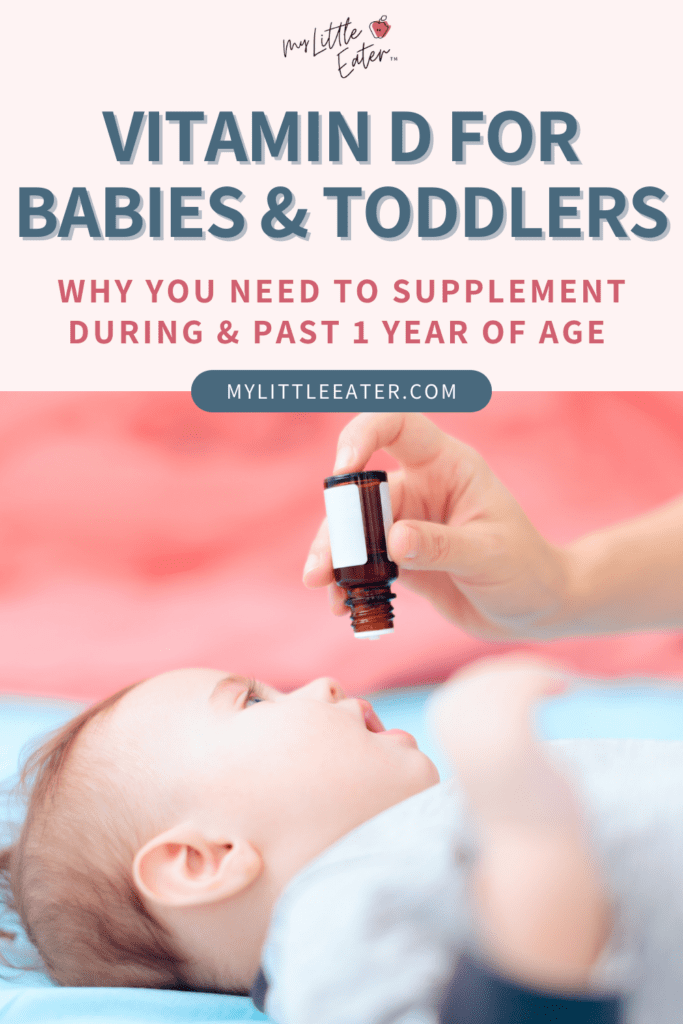
References
- 5 Dietary Guidelines Advisory Committee. 2020. Scientific Report of the 2020 Dietary Guidelines Advisory Committee: Advisory Report to the Secretary of Agriculture and the Secretary of Health and Human Services. U.S. Department of Agriculture, Agricultural
- Abrams, S. A. Vitamin D in preterm and full-term infants. Annals of Nutrition and Metabolism, 76(Suppl. 2), 6-14, 2020.
- Canada, H., for Canada, B. C., & Canadian Paediatric Society. Nutrition for healthy term infants: recommendations from birth to six months. Canadian journal of dietetic practice and research: a publication of Dietitians of Canada= Revue canadienne de la pratique et de la recherche en dietetique: une publication des Dietetistes du Canada, 73(4), 204, 2012.
- Greer, F. R. Issues in establishing vitamin D recommendations for infants and children. The American journal of clinical nutrition, 80(6), 1759S-1762S, 2004.
Golden, N. H., Abrams, S. A., Committee on Nutrition, Daniels, S. R., Abrams, S. A., Corkins, M. R., … & Schwarzenberg, S. J. Optimizing bone health in children and adolescents. Pediatrics, 134(4), e1229-e1243, 2014. - Moon, R. J., Davies, J. H., Cooper, C., & Harvey, N. C. (2020). Vitamin D, and maternal and child health. Calcified Tissue International, 106, 30-46, 2020.
- Vitamin D Recommendations for Perinatal Women & Healthy Term Infants (Birth – 1 year). Background Paper for Health Professionals in British Columbia. 2018. Retrieved from https://www2.gov.bc.ca/assets/gov/health/managing-your-health/healthy-eating/vitamin-d-recommendations-perinatal.pdf
- Wagner, C. L., Greer, F. R., & Section on Breastfeeding and Committee on Nutrition. Prevention of rickets and vitamin D deficiency in infants, children, and adolescents. Pediatrics, 122(5), 1142-1152, 2008.
- Chang, S. W., & Lee, H. C. Vitamin D and health-The missing vitamin in humans. Pediatrics & Neonatology, 60(3), 237-244, 2019.
- Jullien, S. Vitamin D prophylaxis in infancy. BMC pediatrics, 21(Suppl 1), 319, 2021.
- Login, N. R. P., & Initiative, A. (2022). Preventing symptomatic vitamin D deficiency and rickets among Indigenous infants and children in Canada, 2022.
- Caring for kids. Canadian Pediatric Society. Vitamin D. 2021. Retrieved from https://caringforkids.cps.ca/handouts/pregnancy-and-babies/vitamin_d
- CDC. Nutrition. Vitamin D. 2021. Retrieved from https://www.cdc.gov/nutrition/infantandtoddlernutrition/vitamins-minerals/vitamin-d.html#:~:text=And%20How%20Much%3F,of%20vitamin%20D%20each%20day
- Vitamin, D. Fact sheet for health professionals. Natl. Institutes Heal. Off. Diet. Suppl. Available online https//ods. od. nih. gov/factsheets/VitaminC-HealthProfessional, 2017.
- Dietitians of Canada. Food Sources of Vitamin D. 2016. Retrieved from https://www.sarahremmer.com/wp-content/uploads/2016/12/FACTSHEET-Food-Sources-of-Vitamin-D.pdf
- Koo, W. W., Hockman, E. M., & Dow, M. Palm olein in the fat blend of infant formulas: effect on the intestinal absorption of calcium and fat, and bone mineralization. Journal of the American College of Nutrition, 25(2), 117–122, 2006.
- World Health Organization. Vitamin D Supplementation for Infants. 2017. Retrieved from https://www.who.int/tools/elena/bbc/vitamind-infants
- Neale, R. E., Khan, S. R., Lucas, R. M., Waterhouse, M., Whiteman, D. C., & Olsen, C. M. The effect of sunscreen on vitamin D: a review. British Journal of Dermatology, 181(5), 907-915, 2019.
- Vitamin, D. Fact sheet for health professionals. Natl. Institutes Heal. Off. Diet. Suppl. Available online https//ods. od. nih. gov/factsheets/VitaminC-HealthProfessional, 2017.
- Van Ballegooijen, A. J., Pilz, S., Tomaschitz, A., Grübler, M. R., & Verheyen, N. (2017). The synergistic interplay between vitamins D and K for bone and cardiovascular health: a narrative review. International journal of endocrinology, 2017.
- Maresz, K. Proper calcium use: vitamin K2 as a promoter of bone and cardiovascular health. Integrative Medicine: A Clinician’s Journal, 14(1), 34, 2015.

Chelsey Landry, RD
Community Dietitian at My Little Eater Inc., and bunny-mom to Hickory. Chelsey offers one-on-one counselling to parents of babies and toddlers that need more customized support. Learn more by booking a free discovery call with her today!

Chelsey Landry, RD
Community Dietitian at My Little Eater Inc., and bunny-mom to Hickory. Chelsey offers one-on-one counselling to parents of babies and toddlers that need more customized support. Learn more by booking a free discovery call with her today!
 toddler sale! 20% off toddler program with code Toddler20 at checkout
toddler sale! 20% off toddler program with code Toddler20 at checkout 







